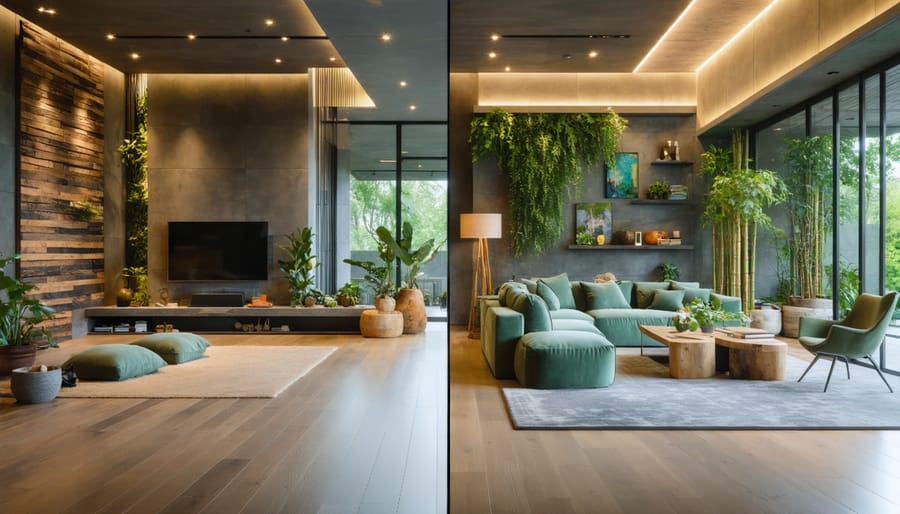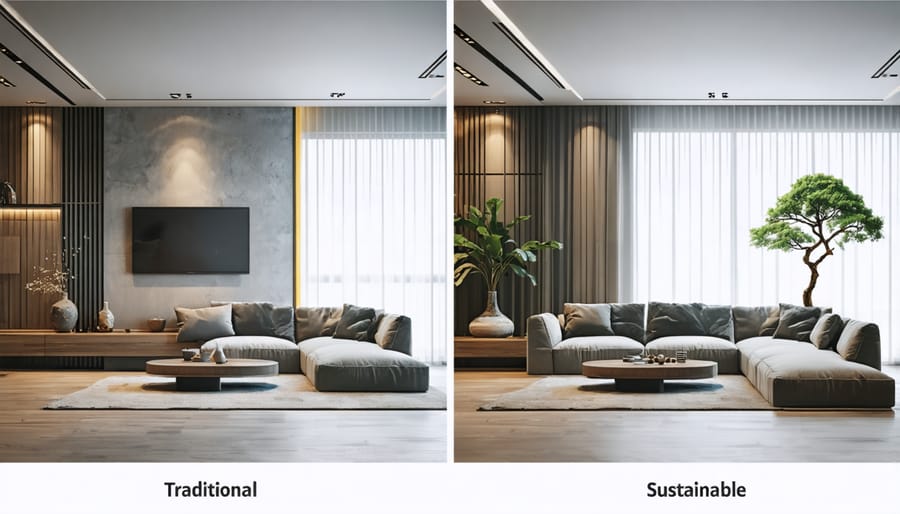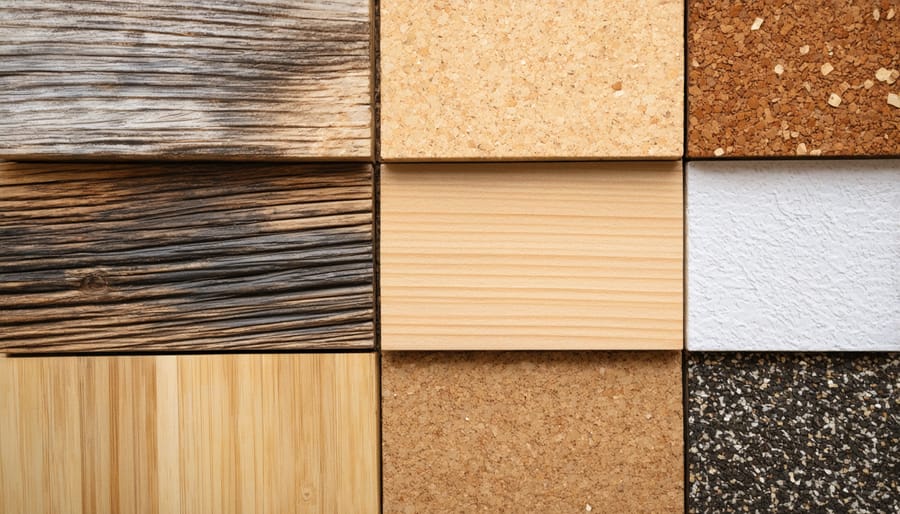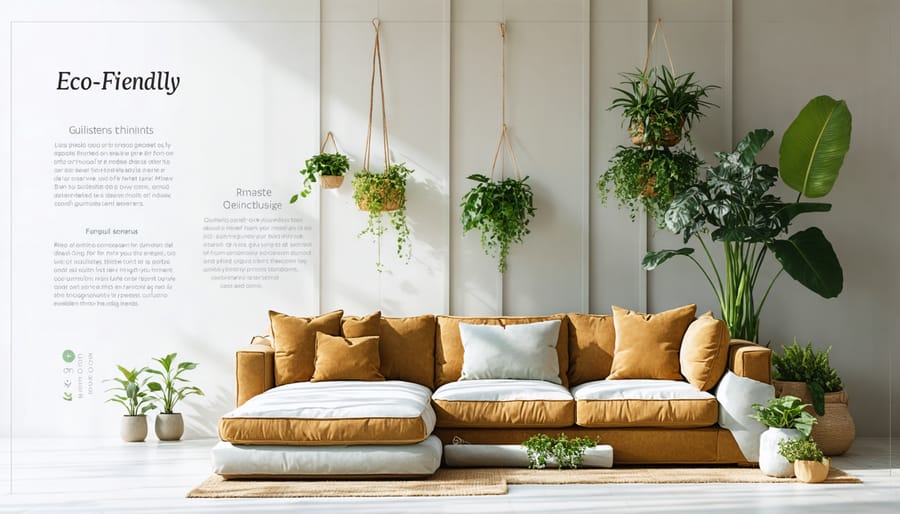
Transform your living spaces while protecting our planet’s future through sustainable interior design materials. The growing demand for eco-friendly interiors has sparked a revolution in how we approach home aesthetics, combining beauty with environmental responsibility. From reclaimed wood flooring that tells a story of preservation to innovative recycled glass countertops that sparkle with purpose, sustainable materials now offer design possibilities that rival or exceed their traditional counterparts.
Today’s eco-conscious homeowners and designers can choose from an impressive array of sustainable options that deliver both style and environmental benefits. Bamboo, cork, and salvaged materials have evolved from alternative choices to premium design elements, while advances in manufacturing have created stunning bio-based products that minimize environmental impact without compromising on durability or visual appeal.
Whether you’re planning a complete home renovation or simply updating a single room, incorporating sustainable materials isn’t just an environmental choice – it’s an investment in healthier living spaces and reduced carbon footprint. These materials often bring additional benefits, including improved indoor air quality, lower maintenance costs, and increased property value, making them a smart choice for both your home and the environment.

Choosing sustainable interior design materials significantly reduces your environmental footprint while creating healthier living spaces. By incorporating biophilic design principles, you actively contribute to resource conservation and waste reduction. Sustainable materials, such as reclaimed wood, recycled metal, and bamboo, require less energy to produce and process compared to their conventional counterparts.
These eco-friendly choices help preserve natural resources by reducing the demand for virgin materials. For example, using reclaimed wood saves mature trees and decreases deforestation, while recycled materials keep valuable resources out of landfills. Many sustainable materials also have a longer lifecycle, reducing the need for frequent replacements and minimizing waste.
The manufacturing processes for sustainable materials typically produce fewer greenhouse gas emissions and require less water usage. Additionally, many eco-friendly materials are biodegradable or recyclable at the end of their life cycle, creating a closed-loop system that benefits future generations. By choosing sustainable materials, you’re not just designing a beautiful space – you’re investing in our planet’s future.
Sustainable interior design materials offer significant health benefits by creating safer, more nurturing indoor environments. By choosing natural, non-toxic materials, you’re actively reducing exposure to volatile organic compounds (VOCs) and other harmful chemicals commonly found in traditional building materials. This approach to bringing nature indoors not only enhances aesthetic appeal but also promotes better air quality and overall well-being.
Materials like bamboo flooring, zero-VOC paints, and organic fabrics help maintain cleaner indoor air by eliminating off-gassing, which is particularly beneficial for individuals with allergies or respiratory sensitivities. Natural wool insulation and cork surfaces naturally resist mold and mildew growth, creating healthier spaces for everyone. Additionally, sustainable materials often incorporate antimicrobial properties without relying on harsh chemical treatments.
The use of reclaimed wood and natural stone brings the added benefit of being free from modern manufacturing chemicals, while certified sustainable materials undergo rigorous testing to ensure they meet strict health and safety standards. This attention to material selection creates spaces that promote both physical health and mental well-being, making sustainable design choices a smart investment in your family’s health.

Incorporating vintage and reclaimed materials into your interior design not only adds character but also promotes environmental sustainability. Reclaimed wood, salvaged from old buildings, barns, and industrial structures, gives new life to existing materials while reducing the demand for fresh timber harvesting.
Salvaged timber offers unique aesthetic appeal through its natural patina, wear patterns, and historical significance. Each piece tells a story, whether it’s weathered barn wood or restored factory beams. Beyond their charm, these materials are often more stable and durable than newly cut lumber, having already gone through years of natural settling and aging.
Bamboo has emerged as a leading sustainable alternative to traditional hardwoods. This fast-growing grass reaches maturity in just 3-5 years, compared to decades for most trees. Modern processing techniques transform bamboo into durable flooring, furniture, and decorative elements that rival traditional hardwoods in both appearance and performance.
For new wood products, look for FSC (Forest Stewardship Council) certification, which ensures responsible forest management practices. These certified woods come from forests where trees are strategically harvested and replanted, maintaining biodiversity and supporting local communities. Popular sustainable options include eucalyptus, acacia, and rapidly renewable pine species.
When selecting wood materials, consider their entire lifecycle impact, including transportation distance, processing methods, and finishing treatments. Local sourcing can significantly reduce the carbon footprint of your interior design choices.
The sustainable textile revolution has transformed interior design, offering beautiful and environmentally conscious alternatives to traditional fabrics. Organic cotton, hemp, and linen lead the way in natural fiber options, requiring significantly less water and pesticides during production while providing durability and timeless appeal. These materials not only create healthier living spaces but also support sustainable farming practices.
Recycled textiles have become increasingly sophisticated, with innovative manufacturers transforming plastic bottles into plush upholstery fabrics and fishing nets into durable carpet fibers. These materials offer the same comfort and style as traditional options while diverting waste from landfills and oceans. For example, recycled polyester fabrics can withstand heavy use while maintaining their appearance, making them ideal for both residential and commercial applications.
Other sustainable alternatives include bamboo fabrics, which grow rapidly without pesticides, and wool from responsible sources, offering natural fire resistance and temperature regulation. Cork fabric, derived from tree bark without harming the tree, provides a unique leather-like alternative that’s both water-resistant and antimicrobial.
When selecting sustainable textiles, look for certifications such as GOTS (Global Organic Textile Standard) or GRS (Global Recycled Standard) to ensure authenticity. These materials often feature unique textures and patterns that can add character to your space while supporting environmental conservation. Many sustainable textiles also offer improved durability and easier maintenance, making them practical choices for long-term use.
Modern eco-friendly finishes and paints have revolutionized how we approach interior design, offering beautiful results without compromising environmental responsibility. Low-VOC (Volatile Organic Compounds) paints lead the way in sustainable finishing options, providing excellent coverage while significantly reducing harmful emissions that can affect indoor air quality. These paints perform just as well as traditional options but are safer for both inhabitants and the environment.
Natural stains derived from plant-based materials offer another excellent alternative for wood surfaces. Coffee, tea, vinegar, and natural oils can create beautiful, unique finishes that age gracefully while remaining completely non-toxic. These treatments often enhance the wood’s natural character while providing protection that’s free from harmful chemicals.
For surface treatments, milk paint and clay-based finishes have gained popularity among environmentally conscious designers and homeowners. These traditional options have stood the test of time, offering durability and a distinctive aesthetic that can’t be replicated with synthetic products. Milk paint, in particular, creates a beautiful, authentic patina that improves with age.
Wax finishes and natural oils, such as tung oil and linseed oil, provide excellent protection while maintaining the material’s natural beauty. These treatments are renewable, biodegradable, and safe to apply. They’re particularly effective on wooden furniture and flooring, creating a rich, warm finish that’s both beautiful and environmentally responsible.
When selecting finishes, look for third-party certifications like GREENGUARD or Green Seal to ensure products meet strict environmental and health standards.

The world of sustainable interior design is evolving rapidly, with innovative materials taking center stage in eco-conscious spaces. Mycelium, derived from mushroom roots, has emerged as a groundbreaking alternative to traditional materials. This naturally-growing substance can be molded into furniture, wall panels, and decorative elements, offering excellent insulation properties while being completely biodegradable.
Cork is experiencing a renaissance in interior design, moving beyond traditional flooring applications. This renewable material is now being transformed into stylish furniture, wall coverings, and acoustic panels. Its natural resistance to moisture and mold, combined with its sound-dampening qualities, makes it an ideal choice for modern sustainable interiors.
Recycled composites are revolutionizing the way we think about durable materials. From countertops made of recycled glass and cement to furniture crafted from reclaimed plastic bottles, these innovative solutions give new life to waste materials. For example, recycled paper and agricultural waste are being compressed into sturdy panels that rival traditional wood products in both strength and appearance.
These materials not only reduce environmental impact but also bring unique aesthetic qualities to spaces. Mycelium offers organic textures and patterns, cork provides warm, natural tones, and recycled composites can be customized in various colors and finishes. As technology advances, these sustainable alternatives are becoming increasingly accessible and cost-effective for both residential and commercial applications.
When selecting sustainable materials for your interior design project, start by researching suppliers with proven environmental certifications. Look for FSC-certified wood products, which ensure responsible forest management practices. Consider materials with high recycled content, such as reclaimed wood, recycled glass, or post-consumer plastic products that can beautifully blend with contemporary design.
Local sourcing should be a priority to reduce transportation emissions and support your community’s economy. Visit architectural salvage yards, which often house unique pieces with character while preventing wasteful demolition. When choosing fabrics, opt for natural fibers like organic cotton, hemp, or wool, which are biodegradable and often produced with fewer harmful chemicals.
Look for transparency in manufacturing processes – reputable suppliers will readily share information about their sustainability practices and material origins. Consider the entire lifecycle of materials, including their durability, maintenance requirements, and end-of-life disposal options. Materials that can be easily repaired or recycled are preferable to those that might end up in landfills.
Digital resources and databases can help you locate certified sustainable materials. Organizations like the Cradle to Cradle Products Innovation Institute maintain directories of verified sustainable products. Don’t forget to request samples before making final decisions – sustainable materials should meet both environmental standards and your aesthetic requirements.
Remember that truly sustainable choices often involve balancing various factors, including durability, local availability, and cost-effectiveness. Sometimes, choosing a slightly more expensive but longer-lasting material can be more sustainable in the long run than opting for cheaper, short-term alternatives.
Proper maintenance of sustainable materials is crucial for maximizing their lifespan and preserving their eco-friendly benefits. Regular cleaning with natural, non-toxic cleaners helps maintain the integrity of bamboo, cork, and reclaimed wood surfaces while avoiding harmful chemical residues. For natural stone and recycled glass surfaces, using pH-neutral cleaners prevents etching and maintains their natural luster.
Many sustainable materials actually become more beautiful with age when properly maintained. Reclaimed wood develops a rich patina over time, while cork flooring’s natural resilience can last decades with proper sealing and periodic refinishing. Natural fabrics like organic cotton and hemp should be cleaned according to specific care instructions to prevent shrinkage and maintain their durability.
Climate control plays a significant role in material longevity. Maintaining consistent indoor humidity levels (between 30-50%) prevents warping in wood products and helps preserve natural fibers. UV protection through window treatments or protective coatings can prevent fading in plant-based materials and natural dyes.
Quick attention to repairs is essential. Small scratches in bamboo can be easily buffed out, while minor damage to cork can be addressed with natural fillers. Many sustainable materials are also inherently easier to repair than their conventional counterparts, reducing the need for replacement and supporting long-term sustainability goals.
Professional maintenance services every few years can significantly extend the life of sustainable materials, making them a smart long-term investment. Regular inspections can identify potential issues before they become serious problems, ensuring your sustainable interior elements remain beautiful and functional for generations to come.
As we’ve explored throughout this guide, sustainable interior design materials offer both environmental benefits and aesthetic appeal for modern spaces. By choosing eco-friendly options like reclaimed wood, recycled metals, bamboo, and natural fibers, you’re not just creating beautiful interiors – you’re contributing to a healthier planet for future generations.
Remember that sustainable design doesn’t mean compromising on style or durability. Many eco-friendly materials actually outperform their traditional counterparts while adding unique character to your space. From VOC-free paints to certified sustainable textiles, the options available today make it easier than ever to create environmentally conscious interiors.
When selecting materials for your next project, consider their full lifecycle impact. Look for certifications like FSC for wood products, GREENGUARD for low-emission materials, and recycled content percentages. Don’t forget to factor in longevity and maintenance requirements – sustainable materials often prove more cost-effective over time due to their durability and timeless appeal.
Start small if you’re new to sustainable design. Even replacing a few conventional materials with eco-friendly alternatives can make a significant difference. As you become more comfortable with sustainable options, you can gradually expand their use throughout your space.
By making informed choices about interior materials today, you’re investing in both the beauty of your space and the health of our environment for years to come.